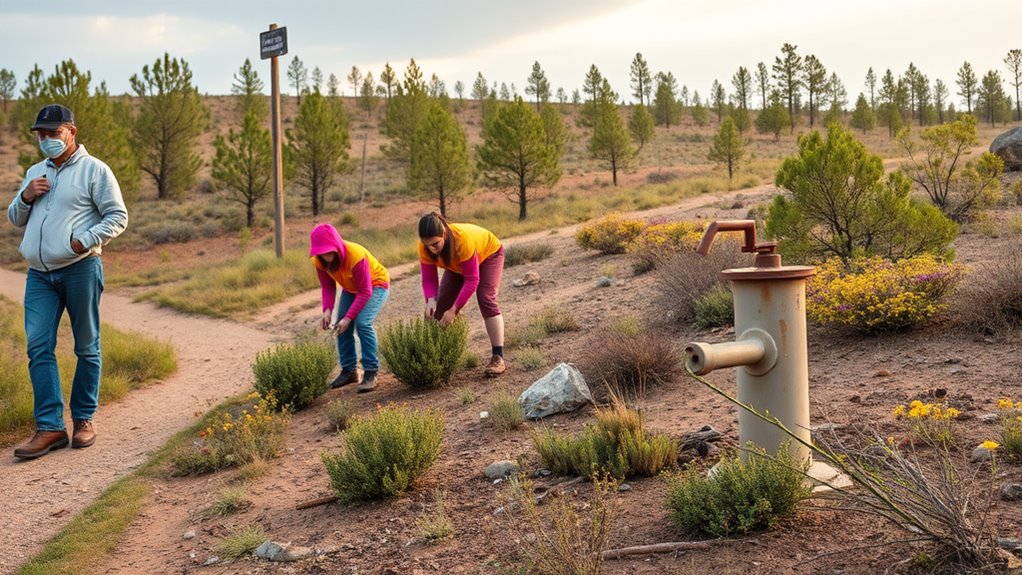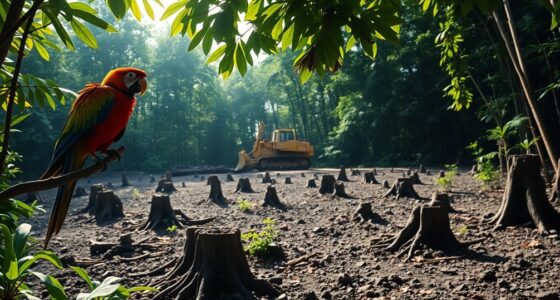To conserve on a budget, you can harness community support by encouraging volunteers and building local partnerships. Use natural, native plantings and affordable barriers to manage habitats effectively. Embrace technology like sensors and drones for low-cost monitoring. Focus efforts on strategic priorities and engage the public through educational programs and social media. By combining these approaches, you’ll maximize resources and see greater impact—if you continue, you’ll discover even more cost-effective conservation tips.
Key Takeaways
- Community partnerships and volunteer programs harness local knowledge, reducing staffing costs and increasing ongoing support.
- Utilizing native plants and natural barriers minimizes habitat restoration expenses and maintenance needs.
- Implementing affordable technology like drones and sensors enhances monitoring efficiency without high costs.
- Engaging the public through social media, workshops, and citizen science maximizes outreach on a limited budget.
- Strategic planning and data-driven prioritization focus resources on high-impact projects for maximum ecological and economic benefit.
Leveraging Community Support and Volunteer Programs

Engaging the community and volunteer programs is a cost-effective way to expand conservation efforts without stretching your budget. Community-led conservation harnesses local knowledge and passion, making projects more sustainable and impactful. Volunteer-driven initiatives allow you to mobilize residents, visitors, and organizations to participate actively in habitat restoration, invasive species removal, or trail maintenance. By involving the community, you foster a sense of ownership and responsibility, encouraging ongoing support. These programs can reduce staffing costs while increasing project capacity. Promoting volunteer opportunities through social media, local events, or partnerships with schools and groups can maximize participation. Additionally, understanding Gold IRA options can provide financial resources to support park projects. Incorporating cost-effective strategies into your planning can further enhance resource management and project success. Building strong community partnerships can also lead to long-term support and additional funding sources. Leveraging volunteer programs not only boosts conservation efforts but also builds a network of dedicated advocates invested in preserving your park’s natural resources. Utilizing reusable tools like eco-friendly supplies can further reduce operational costs and promote sustainable practices within your conservation initiatives.
Utilizing Low-Cost and Natural Solutions for Habitat Management
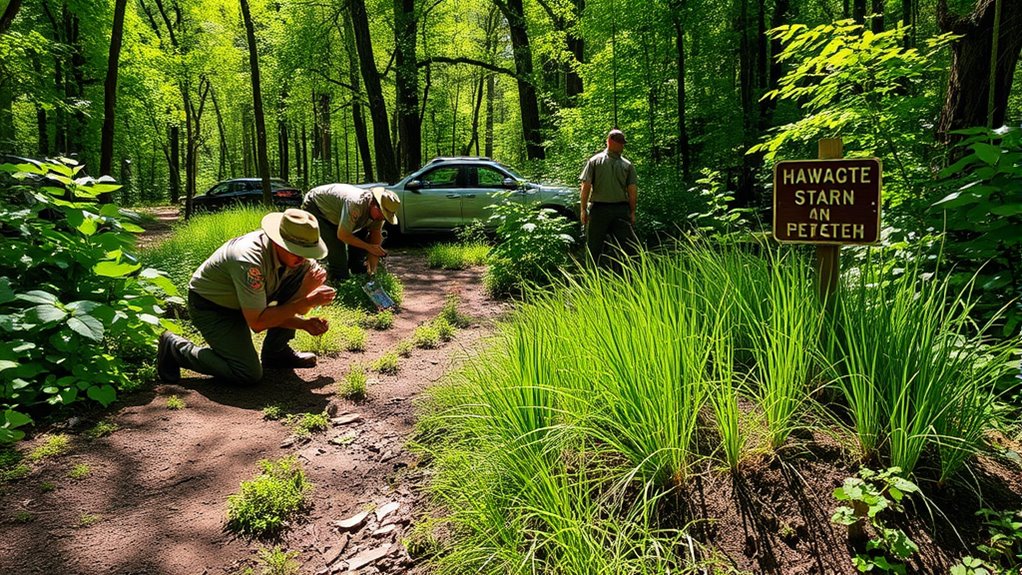
One of the most effective ways to manage habitats without overspending is by utilizing natural solutions that work with the environment rather than against it. Native planting is a cost-efficient strategy that encourages local plant species to thrive, reducing the need for expensive maintenance or chemical treatments. These plants support native wildlife and improve ecosystem stability. Additionally, natural barriers like hedgerows or rock formations can control erosion and define boundaries without relying on costly fencing or signage. Incorporating wall organization systems can also help in managing park resources efficiently and visually enhancing the landscape. By integrating native plants and natural barriers, you create sustainable habitats that require minimal intervention while enhancing biodiversity. Incorporating natural climate solutions can further bolster ecosystem resilience and provide long-term conservation benefits. Implementing ecological restoration practices can help rehabilitate degraded areas with minimal cost and effort. These practices are aligned with holistic conservation principles that emphasize working with natural processes rather than against them. Using cost-effective techniques can significantly reduce overall expenses while maintaining ecological integrity. This approach not only saves money but also fosters a healthier, more resilient ecosystem, making conservation efforts more accessible and effective for cash-strapped parks.
Embracing Technology to Monitor and Protect Ecosystems

By combining natural habitat management with modern technology, conservation efforts become more efficient and impactful. Smart sensors can be placed throughout ecosystems to continuously track environmental conditions, animal movements, and potential threats like poaching or invasive species. These sensors provide real-time data, allowing you to respond quickly and allocate resources effectively. Drone surveillance offers a cost-effective way to monitor large or hard-to-reach areas without the need for extensive foot patrols. Drones can capture high-resolution images and videos, helping identify illegal activities or habitat disturbances early. Together, smart sensors and drone technology empower you to keep a vigilant eye on ecosystems with limited budgets. Incorporating cost-effective tools like drones and sensors enhances protection efforts, reduces costs, and enables more targeted interventions. Moreover, leveraging technological advancements can help maximize resource use and improve conservation outcomes even with constrained budgets.
Partnering With Local Organizations and Stakeholders
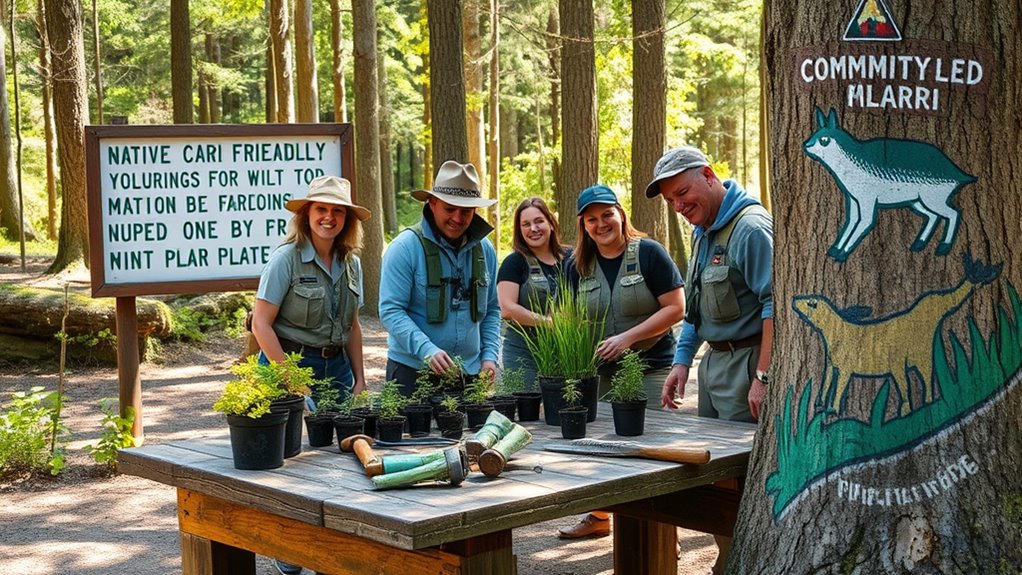
How can you maximize conservation efforts on a limited budget? Partnering with local organizations and stakeholders is key. These collaborations can amplify your impact through:
- Joint fundraising campaigns to pool resources and attract grants.
- Developing wildlife corridors with community input, ensuring habitat connectivity.
- Sharing expertise and volunteers, reducing staffing costs.
- Engaging stakeholders to promote sustainable practices that complement conservation goals.
- Incorporating risk management strategies to identify community strengths and foster more effective partnerships. Additionally, understanding the cookie categories available can help in planning outreach events that demonstrate sustainable camping practices efficiently.
Implementing Cost-Effective Education and Engagement Initiatives
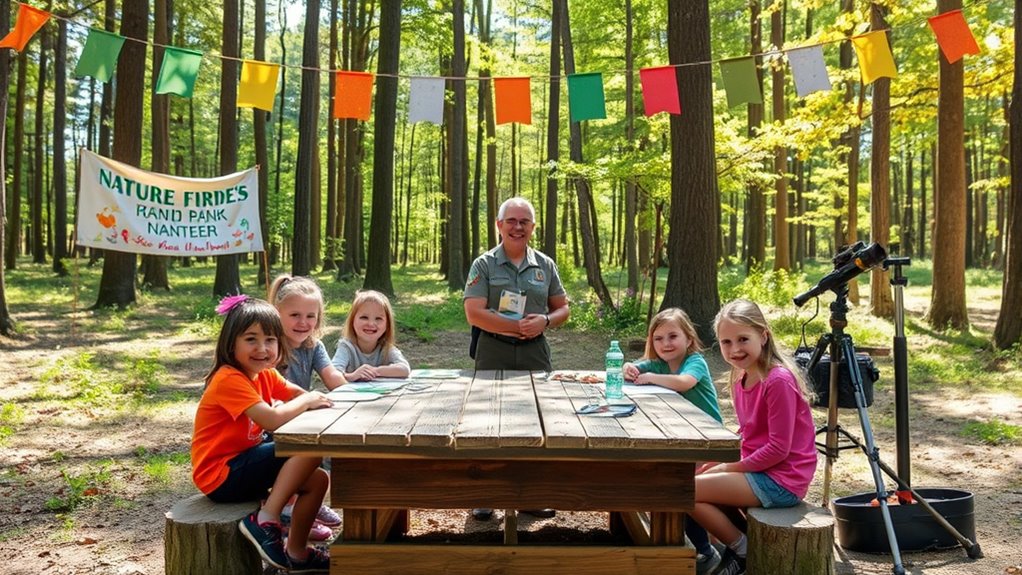
Implementing cost-effective education and engagement initiatives is essential for maximizing your conservation impact without overspending. You can achieve this by using eco-friendly signage made from sustainable materials, which reduces costs and environmental impact. Encourage visitors to explore wildlife photography, turning their interest into a conservation tool by sharing their photos on social media or community exhibits. Hosting volunteer-led workshops or guided walks leverages community involvement without hefty expenses. Digital platforms and social media campaigns offer a low-cost way to spread awareness and engage audiences regularly. Creating interactive, memorable experiences helps foster a deeper connection to conservation efforts without significant financial investment. Incorporating cost-effective educational methods such as interactive displays or citizen science projects can further enhance visitor participation and learning. Additionally, aligning programs with behavioral change principles can increase the effectiveness of outreach efforts. Utilizing community engagement strategies, such as local partnerships and outreach events, can amplify conservation messages at minimal cost. Incorporating personality traits and understanding visitor motivations can also improve the effectiveness of engagement strategies. By focusing on innovative, sustainable methods, you can inspire visitors and promote stewardship effectively, even with limited resources.
Prioritizing Strategic Planning and Resource Allocation

To make the most of your limited resources, focus on data-driven decision making that highlights which projects will have the greatest impact. Prioritize initiatives that deliver high value and align with your conservation goals. This strategic approach helps guarantee every dollar is used effectively to protect what matters most. Additionally, understanding the importance of resource allocation can ensure efforts are directed where they are most needed and effective.
Data-Driven Decision Making
Data-driven decision making is essential for effective conservation on a budget, as it helps you identify the most impactful actions and allocate resources efficiently. By analyzing data, you can prioritize efforts such as establishing wildlife corridors, which connect fragmented habitats and support species movement. It also enables you to target invasive species control, preventing ecological imbalance. To maximize your impact, consider these steps:
- Map critical habitats and identify connectivity gaps.
- Use surveys and remote sensing to detect invasive species spread.
- Allocate funds toward projects with measurable outcomes.
- Continuously monitor and adjust strategies based on data insights.
- Employ ethical hacking principles, such as vulnerability assessments, to identify potential threats to conservation data security and ensure integrity. Regularly reviewing security measures can help safeguard sensitive ecological data from cyber threats.
This approach guarantees your limited resources support high-impact initiatives, fostering resilient ecosystems despite budget constraints.
Focusing on High-Impact Projects
Focusing on high-impact projects guarantees that your conservation efforts deliver the greatest benefit for your limited resources. Prioritize initiatives like native plant restoration, which can quickly enhance biodiversity and stabilize ecosystems. Implement eco tourism models that attract visitors sustainably, generating revenue to fund future projects. By strategically selecting projects with measurable environmental and economic outcomes, you maximize your park’s impact. Avoid spreading efforts thin across less effective activities; instead, concentrate on initiatives that offer the most significant conservation return. This targeted approach ensures your scarce resources are used efficiently, creating lasting environmental improvements. Additionally, leveraging diverse funding sources can further extend your conservation capabilities and sustainability. Emphasizing the importance of efficient resource allocation helps ensure that every effort yields maximum environmental benefit, especially when budgets are limited. Incorporating strategic planning can also guide you in identifying the most effective projects to pursue with your available resources. Engaging the community in local biodiversity initiatives can also amplify conservation success and foster ongoing support. Recognizing the role of energy-efficient equipment can further reduce operational costs and conserve resources in park management.
Frequently Asked Questions
How Can Parks Attract Long-Term Volunteer Commitment Without Extra Funding?
You can boost volunteer retention and foster community engagement by creating meaningful, varied opportunities that make volunteers feel valued. Recognize their efforts regularly, offer leadership roles, and involve them in decision-making. Building a welcoming environment, hosting social events, and sharing success stories also strengthen commitment. These strategies encourage volunteers to stay long-term without extra funding, as they see their impact and feel connected to the park’s mission.
What Are Some Unexpected Natural Solutions for Invasive Species Control?
Imagine a quiet pond, where natural predators quietly keep invasive species in check. Biological control introduces beneficial organisms, like certain insects or fungi, to target invasive plants or pests. This method enhances ecosystem resilience, allowing native species to recover naturally. It’s an unexpected, eco-friendly solution that leverages nature’s own balance, reducing the need for chemical treatments and fostering a healthier, more resilient environment without extra costs.
How Can Technology Be Made More Affordable for Small or Rural Parks?
You can make technology more affordable for small or rural parks by exploring affordable innovations and DIY tech solutions. Start by sourcing open-source software and low-cost hardware like Raspberry Pi or Arduino to develop custom monitoring or conservation tools. Collaborate with local communities or volunteers to build and maintain these systems, reducing costs. This approach allows you to implement effective conservation measures without straining your limited budget.
What Strategies Help Secure Local Stakeholder Buy-In With Limited Budgets?
You can win local stakeholder buy-in by fostering genuine community engagement and partnership building. Share your vision transparently, highlight mutual benefits, and involve residents in decision-making. Use small, impactful initiatives to demonstrate progress, making stakeholders feel valued and invested. Building trust and collaboration helps stretch limited budgets, as community members often contribute time, resources, and ideas, amplifying conservation efforts without significant costs.
How Do Parks Measure the Success of Low-Cost Conservation Initiatives?
You measure the success of low-cost conservation initiatives by tracking wildlife monitoring data and community engagement. Wildlife monitoring helps you observe population health and habitat changes over time, indicating if efforts are effective. Community engagement shows how well locals participate and support conservation activities. When both indicators improve or stay stable, you can confidently say your initiatives are successful, even with limited funds.
Conclusion
By tapping into community support, volunteers, and affordable natural solutions, you can make a real impact even on a tight budget. Imagine a small park using local groups to restore native plants, or installing simple, cost-effective monitoring tech to track wildlife. These strategies prove that with creativity and collaboration, you can protect ecosystems without breaking the bank. Every effort counts—your commitment can help preserve nature for generations to come.
